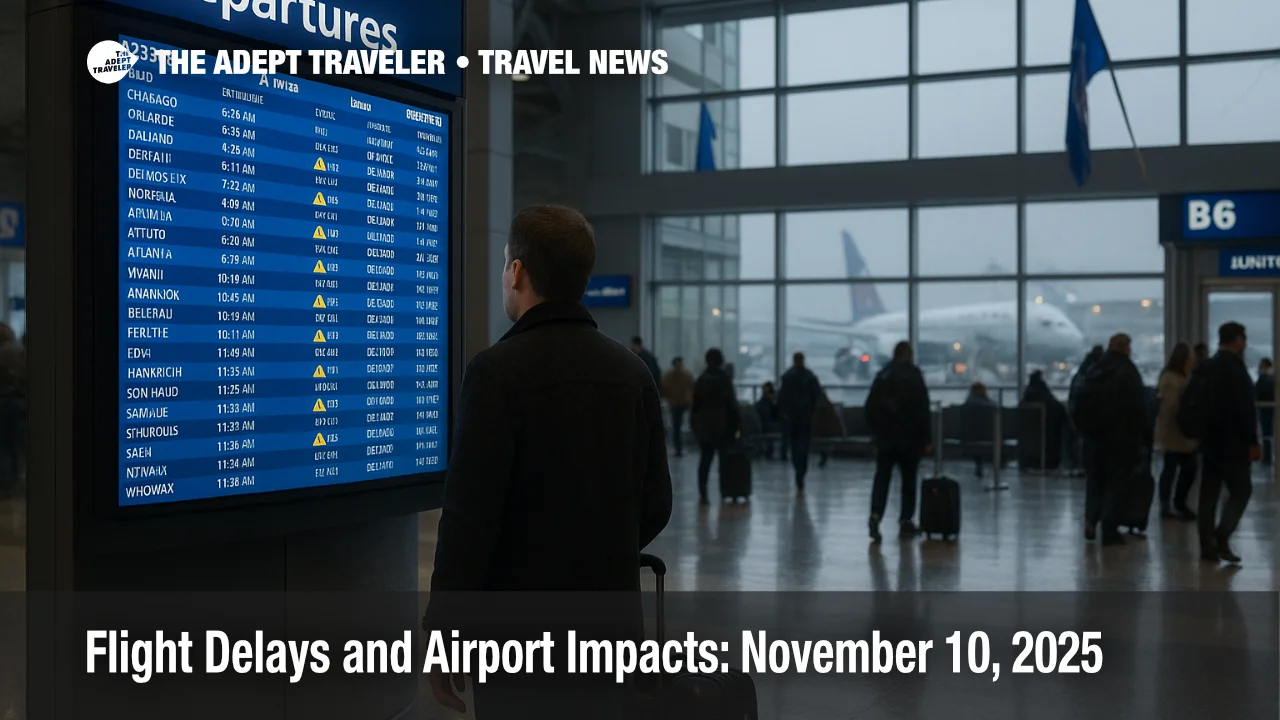Flight Delays and Airport Impacts: November 10, 2025

Key points
- FAA publishes an O'Hare Ground Delay Program due to winter weather and staffing triggers
- Nationwide schedule trims tied to the shutdown continue, with more than 1,500 U.S. cancellations reported by early morning
- Lake effect snow narrows south and east after daybreak in Chicago, but slick conditions and variability persist near the lake
- Additional arrival delays reported in Detroit due to staffing, and Miami oceanic sectors note potential impacts
- Travelers should allow generous buffers, monitor airline apps, and move to earlier departures where possible
Impact
- Expect Longer Queues And Taxi Times
- ORD arrivals are metered, connections are tighter, and turnaround times stretch under GDP procedures
- Pad Connections To 3 Hours Or More
- Weather plus staffing means irregular operations at multiple hubs, especially ORD and EWR
- Rebook Earlier Flights Or Alternate Airports
- Same-day moves off peak banks reduce misconnect risk when space is available
- Use Airline Apps And Alerts
- Push notifications surface waiver options and auto-rebooking faster than call centers
- Verify Chicago Ground Transport
- Lake effect bands shift through late morning, so plan extra time between terminals and downtown
A messy Monday starts with a Ground Delay Program at Chicago O'Hare International Airport (ORD) and continued nationwide schedule trims as the FAA manages staffing constraints during the shutdown. By early morning, more than 1,500 U.S. flights were canceled for Monday and hundreds more delayed, and lake effect snow around Chicago produced highly variable conditions over short distances. Travelers connecting through O'Hare, Newark, Detroit, and other busy hubs should budget generous buffers, consider moving to earlier departures, and monitor airline apps for rolling reaccommodation.
FAA and Chicago, what changed
The Air Traffic Control System Command Center published a Ground Delay Program for O'Hare due to winter weather in the Chicago ARTCC area and multiple staffing triggers across the National Airspace System. The same advisory added arrival delays for Detroit's D21 TRACON and noted potential impacts in Miami's oceanic sectors. In short, arrivals into O'Hare are being metered, so inbound flights get arrival slots that space traffic, which cascades into longer taxi-out times and tighter connections.
Latest developments
Early morning operational data show thousands of flights affected as the day begins, with cancellations already surpassing 1,500 nationwide. That early toll reflects the second week of FAA-directed schedule trims after a prolonged federal shutdown that has stressed controller staffing. Newsroom tallies drawing on FlightAware data indicate the weekend set the pattern, and Monday is tracking similarly. Expect additional trims through the day, especially if weather interferes with recovering rotations.
In Chicago, the National Weather Service reports that the most intense lake effect band shifts southeast after daybreak. Conditions remain slick where the band lingers, and totals vary block to block. The key for air travel is that even as the snow ribbon moves, the morning bank at O'Hare and Midway still sees deicing and runway configuration changes, which feed delays.
Background
How a Ground Delay Program works. When weather or staffing reduces arrival capacity at a hub, the FAA assigns Estimated Departure Clearance Times to flights bound for that airport. Those EDCT times meter arrivals to the available acceptance rate, smoothing inbound flows and reducing holding in the air. For travelers this means later departures from origins, longer time on the ground waiting for wheels-up, and increased risk of misconnecting. The safest play is to pad connections to three hours or more when a GDP is active, especially during morning and late-afternoon peaks.
Analysis
Monday's pressure points align with policy and weather. FAA staffing triggers continue to generate system-wide drag, and O'Hare's winter weather compounds it, so connections that would normally clear may now miss by minutes. Detroit, Newark, and Boston can inherit the ripple as flows are spaced, and Miami's oceanic sectors may slow transits for Caribbean and Latin America flights. That mix favors proactive changes. If you are ticketed today, move to an earlier departure, widen buffers, and, if feasible, route around O'Hare. If you are already en route, ask a gate agent to protect you on the next bank before you land.
Airlines will continue to shape schedules to the FAA's caps. Expect day-of swaps to larger aircraft on trunk routes, thinning frequencies on mid-continent spokes, and slower recovery on low-frequency city pairs. FlightAware's live dashboard remains the best gauge of where cancellations are clustering on the hour. Pair that with your carrier's mobile app for same-day change options and with airport social feeds for terminal-side constraints like deicing queues and ramp closures.
Final thoughts
Flight delays and airport impacts on November 10 are driven by two forces, FAA staffing management and Chicago's lake effect snow. Neither is catastrophic on its own, but together they mean tighter connections and a higher chance of missed flights. Protect your itinerary with earlier departures, longer buffers, and continuous monitoring of airline alerts.
